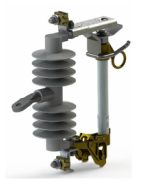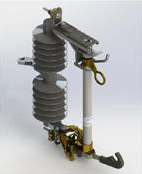CATEGORIES
Cutouts
In electrical distribution, fuse cutouts are a combination of a fuse and a switch, used primarily in overhead feeder lines and taps to protect distribution transformers from current surges and overloads. An over-current caused by a fault in the transformer or customer circuit will cause the fuse to melt, disconnecting the transformer from the line. A cutout consists of three major components: First, the cutout body, is an open “C”-shaped frame that supports the fuse holder and a ribbed porcelain or polymer insulator that electrically isolates the conductive portions of the assembly from the support to which the insulator is fastened. Second, the fuse holder, also called the “fuse tube” or “door”, is an insulating tube which contains the replaceable fuse element. When the contained fuse melts, or “blows,” the fuse holder drops out of the upper contact, breaking the circuit, and hangs from a hinge on its lower end. The third component, the fuse element, or “fuse link,” is the replaceable portion of the assembly that melts and breaks the circuit when the electric current through it exceeds its rated current value.
Showing all 3 results
Showing all 3 results



